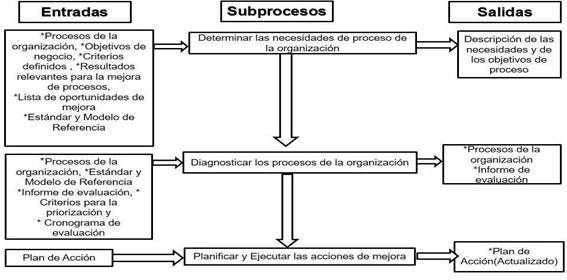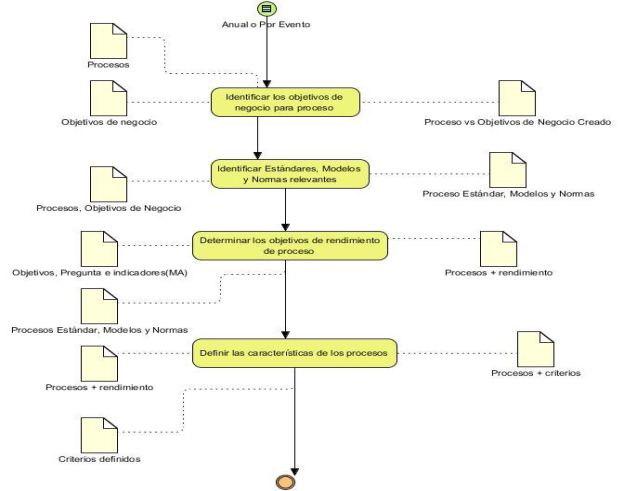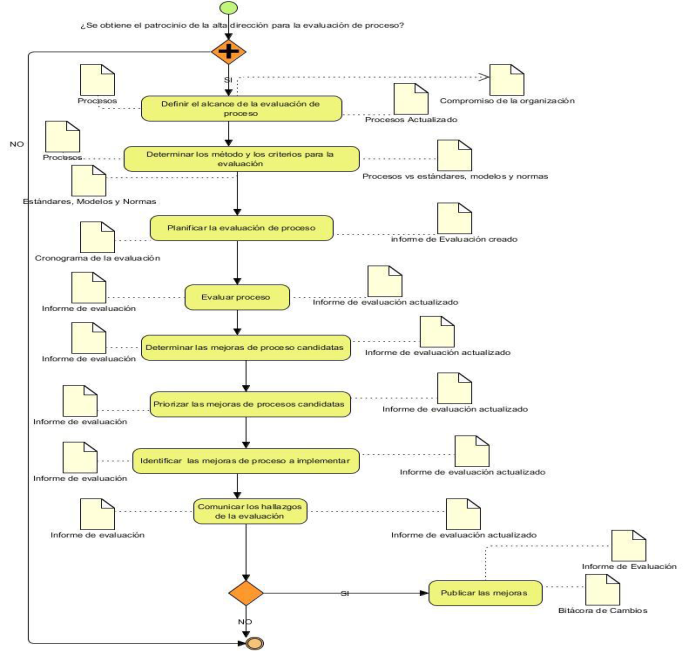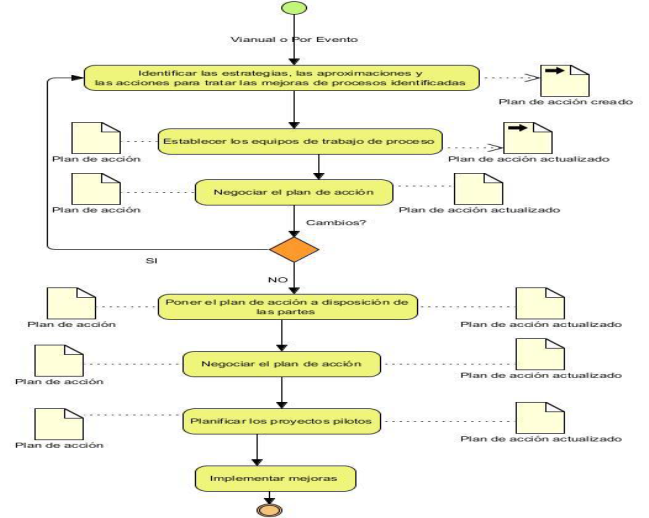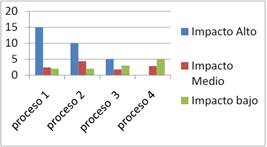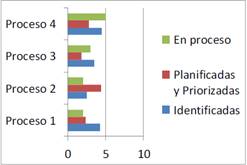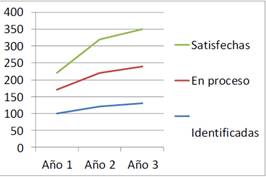Introducción
The advance of Information and Communication Technologies (ICTs) has boosted the use of IT products in all spheres of society. (Wang, y otros, 2021) (Zhang, 2022). The accelerated and massive use of these products requires producers to develop more secure, usable, adaptable and continuously evolving products according to their application. (Tarricone, 2021), (Petcu, 2021). To stay in the market, organizations must be increasingly competitive and need to meet the expectations of their customers, who demand high levels of quality. (Zouari, y otros, 2021), (Tarigan, 2021). However, the data published by the Standish Group reflect that software production demands improvements in the institutionalization of software engineering and management practices (Avalos, 2020) (Palleiro, 2020) (Bautista, 2020). Cuba is no stranger to the development of Information and Communication Technologies, the Cuban Software Industry works in the search for new alternatives and ways with the objective of generating greater income to contribute to the development of the economy. (Watson, 2021), (Staniskis, 2022). The economic impact is one of the pillars of science, technology and society. The application of the process has a positive impact on the fulfillment of the guidelines of the economic policy, highlighting the impact of the proposal of the V. Science, Technology, Innovation and Environment Policy in the guidelines: Guideline 83: "Work to guarantee, by companies and entities linked to exportation, that all goods and services destined for international markets meet the highest quality standards". Guideline 74: "To place the role of science, technology and innovation in the foreground at all levels, based on the government's work strategy with scientific institutions, the mission of the Cuban Academy of Sciences and the implementation of approved policies, with a broad sense of participation in the fulfillment of the objectives of the National Economic and Social Development Plan. Guideline 81: Continue the development of the technological-logical and telecommunications infrastructure, within the Informatization Process of Society, as a dynamizing factor of the economy. To advance in a sustainable manner in correspondence with the economic possibilities of the country. To advance in the development of the government and electronic commerce, with priority in the computerization of the processes, the services on line between the institutions and towards the citizens, that contributes to a greater efficiency, effectiveness and transparency of the public administration, the economy and quality of life of the population. To develop the Industry of Informatics and Telecommunications Applications and Services, based on the articulation of the different actors of the economy, as a support for the Informatization Process of the Society, creating new and better services to the population and contributing to the substitution of imports, to the increase and diversification of exports.¨ Guideline 84¨ To sustain the progress of the Informatization of the Society in a System of Cybersecurity and management of the radioelectric spectrum, which strengthens the National Defense and Security. Raise the culture of responsible use of Information and Communication Technologies (ICTs) by institutions and citizens, as well as the confrontation of their illegal, harmful, subversive and destabilizing use. To increase international collaboration mechanisms in this field.
The fundamental contribution from the economic point of view for those software development institutions that implement the proposed framework is given in the reduction of non-quality costs, which are derived from internal and external failures, i.e. defects and non-conformities. Quality costs are divided into four categories according to their nature: prevention costs, evaluation costs, internal failure costs and external failure costs. (Ampatzoclou, 2021), (Jasiulewicz-Kaczmarek, 2021)When observing the manifestations or consequences of these categories of costs, it is easy to notice that the costs of internal failures and external failures would be more expensive to eliminate after their materialization, since they are manifested after the software is finished, which leads to reprocessing that may imply changes in product requirements, rework and, what is worse, could threaten customer satisfaction and the motivation of the development team (Martín, 2021) (Zabala, 2021) (Verdecia, 2020) .
The UCI has a set of centers that develop activities of Research, Development and Innovation, for computer applications, technological development and associated research, as a whole, form a collaborative network that operates under the processes established in the same as a result of the use of good practices of the CMMI model, enabling the reuse of components. As part of the improvement of the production processes of the network of centers, the use of several support tools has been standardized, such as: EXCRIBA, which allows document management, where all the evidence of the artifacts generated in the different processes is stored, GESPRO helps project management for the planning, control and monitoring of projects, and GIT, which allows all the management of the source code of computer applications. The university with the objective of evaluating, certifying and accrediting the software production process, opted for the CMMI evaluation, this is a maturity model of process improvement for the development of products and services. It includes best practices that address development and maintenance activities covering the product life cycle, from conception to delivery and maintenance (Calderon, 2020) (Reyes, 2021) (Sierra, 2020). Although the university was certified with a CMMI-DEV v1.3 level 2 for certified development projects, as well as its staff trained in the process areas of this level, there are still elements to mature and apply to its productive activity. It is important to continue the evolution of its processes, as well as the improvement of these in organizations, requires a great effort, which is difficult to address, carries elements of change, prevents at some point to begin to institute. However, Calisoft developed the MCDAI, which evaluates the quality of the development process of organizations producing software applications, through the assessment of the conformity of these processes, is composed of three fundamental guides: General, Implementation and Evaluation, each of these guides has a series of branch rules, defines the processes by categories and in turn for each level. There is the process of Process Management in the management of the organization, where it defines the purpose, the expected results for the different levels, as well as the specific requirements for each level.
For the evaluation of the organization with the objective of studying and specifying how to implement good practices in software development, it is not known how the organization performs from having a set of opportunities for improvement which to address first and which later. It is done empirically without leaving evidence for future process improvement projects and there is a risk that the fluctuation of personnel may cause the loss of undocumented knowledge. The survey showed that some of the activities related to improvement opportunities are carried out. Those that obtained a higher percentage of execution were the identification and determination of opportunities for process improvements. It can be stated that the activities of planning and implementation of actions, deployment of assets, incorporation of process experience, are not performed. Interviews were conducted with project leaders and quality managers that allowed to know other elements such as the few existing evidences, associated to the treatment of improvement opportunities, the evidences of the actions are not stored when they are carried out. From the above, it is concluded that there is currently no process in charge of planning, implementation and deployment of improvement opportunities. Processes lag behind practices are not addressed and it is not possible to maintain a continuous evolution of them. When you have a set of improvement opportunities that arise from an external or internal evaluation, you do not know how to proceed to treat all or the most relevant ones for the organization, this is done empirically. A process is needed that governs how to treat the various improvement opportunities that arise in the organization, as well as prioritizing which should be done first and which later until the improvement is deployed.
Métodos o Metodología Computacional
The general policy of the process is: Continuous improvement of organizational processes through planning, implementation and deployment of improvements throughout the organization. At the University of Informatics Sciences, as part of the implementation of an improvement project, the process IPP-2018 Organizational Process Improvement Process was defined, which describes the steps to define the different processes of the productive activity. Its scope is oriented to all the processes of the productive activity of the UCI as part of the improvement project of the institution. It also serves to any software producing organization in Cuba.
Process Policies
Determine process improvement opportunities: where policies, standards and business objectives that are applicable to the organization's processes should be identified, examine relevant standards and process models of good practices, define main characteristics of the organization's processes, document the organization's process needs and objectives.
Establish process action plans: identify strategies, approaches and actions to address identified process improvements, establish process action teams, document process action plans, review and negotiate process action plans with relevant stakeholders.
Evaluate the organization's processes: senior management and staff of the organization should be engaged in the process evaluation, define the scope of the process evaluation, determine the method and criteria to be used, plan, schedule and prepare the process evaluation, evaluate the process, document and deliver the evaluation activities and findings, communicate the evaluation findings.
For the implementation of the process it is necessary that the following execution conditions are met:
To have the information of the organization that constitute input to the process.
To have institutionalized organizational processes.
To have a reference model.
To count on the organization's managers for decision making.
To carry out a process it is necessary to assign roles and commit the members of the organization with their responsibilities, which must be well defined. Any organization wishing to execute the process must form the following work teams:
Process Improvement Steering Group: has as its main priority to align the improvement effort with the organization's vision and mission and business objectives. Provide the resources for process improvement. It is in charge of forming the work teams, approving the prioritized improvements, the improvement action plan, the improvements and the process evaluation results report. Follows up on the results and directs corrective actions. Participates in the deployment of processes. Facilitates and manages the organization's process improvement activities, including coordinating the involvement of others, usually assigned to a process group.
Process Engineering Group: focuses on achieving harmony between organizational processes and organizational standards. Aligns the work of the technical working groups through training and participation in the description and documentation of the improved process. Monitors the results obtained compared to plans.
Technical working group: its responsibility is to define and improve processes based on improvement opportunities, investigates problems and generates solutions. Verifies changes in pilot projects. Develops implementation plans. Participates in the deployment of processes.
Evaluation team: in charge of evaluating the processes. Document and deliver evaluation activities and findings. Communicate evaluation findings. Facilitate communication with the evaluation teams. Plan, schedule and prepare the evaluation.
Resultados y discusión
In order to provide the management of an organization with an objective view of the status of improvement opportunities, it is necessary to have a system of indicators capable of showing progress from monitoring, with the plans established in the organization. The analysis of historical results will allow to know the progress achieved, as well as to identify the processes with more opportunities for improvement that support the priorities. This system allows assessing the usefulness of the organizational process improvement process.
Indicator #1: Objective: Determine the most critical processes based on those with the most opportunities for improvement. To do so, it is necessary to: Know the high, medium or low impact of improvement opportunities by process. Preguntas ¿Cuáles son los procesos más críticos en cuanto a las oportunidades de mejora? ¿Cuáles son los procesos que deben ser mejorados a corto, mediano y largo plazo?
Indicator #2: Objective: To know the progress in the resolution of improvement opportunities. This requires: The status of improvement opportunities: identified, planned and prioritized, in process, in pilot, closed.
Questions What are the processes of identified improvement opportunities? What are the processes of planned and prioritized improvement opportunities? What are the processes of process improvement opportunities?
Indicator #3: Objective: To evaluate the process improvements in organizational processes. To do so, it is necessary: To know the number of improvement opportunities for each year, according to the identified, in-process and closed status. Questions What is the highest number of identified improvement opportunities? What is the highest number of process improvement opportunities? What is the highest number of closed improvement opportunities?
Indicator #3: Objective: To evaluate the process improvements in organizational processes. To do so, it is necessary: To know the number of improvement opportunities for each year, according to the identified, in-process and closed status. Questions What is the highest number of identified improvement opportunities? What is the highest number of process improvement opportunities? What is the highest number of closed improvement opportunities?
Conclusión
The international models, standards and guidelines analyzed propose, from different perspectives, the inclusion of good practices for process improvement in organizations to ensure the quality of their processes and products throughout the software development cycle, but they do not specify how to perform the activities, roles and artifacts that facilitate their implementation throughout the process. A process was designed that establishes how to use good practices proposed in international models, standards and guidelines, containing policies, sub-processes, activities, roles and their responsibilities, as well as artifacts. The validation of the process guarantees the continuous evolution of the processes in the organizations from the planning, implementation and deployment of the improvement opportunities to the processes.













